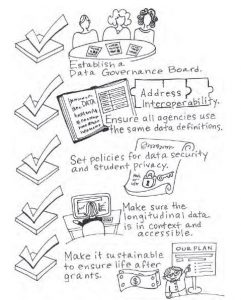In my first blog post in the Education meets Big Data blog series, I explained the need for Statewide Longitudinal Data Systems(SLDS). In the blog post following, I shared an interview with Armistead Sapp, one of the authors of the book, "Implement, Improve and Expand Your Statewide Longitudinal Data System."
In this post, we discuss the key steps in preparing for your SLDS. If you are in a state that is just getting started, or doing major renovations to your SLDS, these steps can help you address the key concerns to set up your system for future growth, use, and success.
- Establish a Data Governance Board. In these early days, a data governance body is a vital group to give the project focus, leadership and momentum and establish the processes that give SLDSs a strong foundation. This is the very first task in setting up a new SLDS for success.
- Address interoperability of the data, ensuring all agencies use the same data definitions and compatible systems. A major prerequisite for having an SLDS that can provide accurate answers is that the data accessed from different sources are compatible and share a common student UID (unique identifier).
- Set policies for data security and student privacy to ensure the SLDS is safer than current ad hoc systems. Paramount to any data system is the issue of security and student information privacy. While many laws and policies have impacted the development and operation of SLDSs, when it comes to student information, the Family Educational Record Privacy Act of 1974 (FERPA) is the law with the biggest impact on SLDSs.
- Evaluate current systems and make connections to ensure the longitudinal data are in context and accessible to those who need them. K–12 systems have existed for several years. Given this fact, interoperability will need to be addressed early on, as all systems are unlikely to be in compatible formats. Even if a state is establishing its first K–12longitudinal data system, it must have an eye toward how the system will grow to include data from other sources in the future. This inclusion of workforce, social services, health, higher education and early childhood data (to name a few) is the next frontier for SLDSs.
- Make it sustainable to ensure the SLDS can thrive in life after grants. SLDSs take years to establish, with a substantial time commitment involved in the planning and implementation phases. Additionally, SLDSs are only an asset when multiple years of data exist. These realities mean that even in the best scenarios, it will take years before a state’s SLDS can embody all of the benefits on which it’s sold. They are, unarguably, a long-term investment that makes it even more necessary to keep them up and running for a long time and continually communicate with stakeholders to prove their worth. Often, high levels of federal funding are at stake and the need to get the system right is strong.
While I focused this blog post on SLDSs, keep in mind that these key steps can be generalized and utilized for any data management system for analysis and reporting.
To learn more about these key steps for a successful SLDS, read the Chapter 3 excerpt from the book entitled, "Implement, Improve and Expand Your Statewide Longitudinal Data System."
Stay tuned for another upcoming blog post regarding SLDSs.
